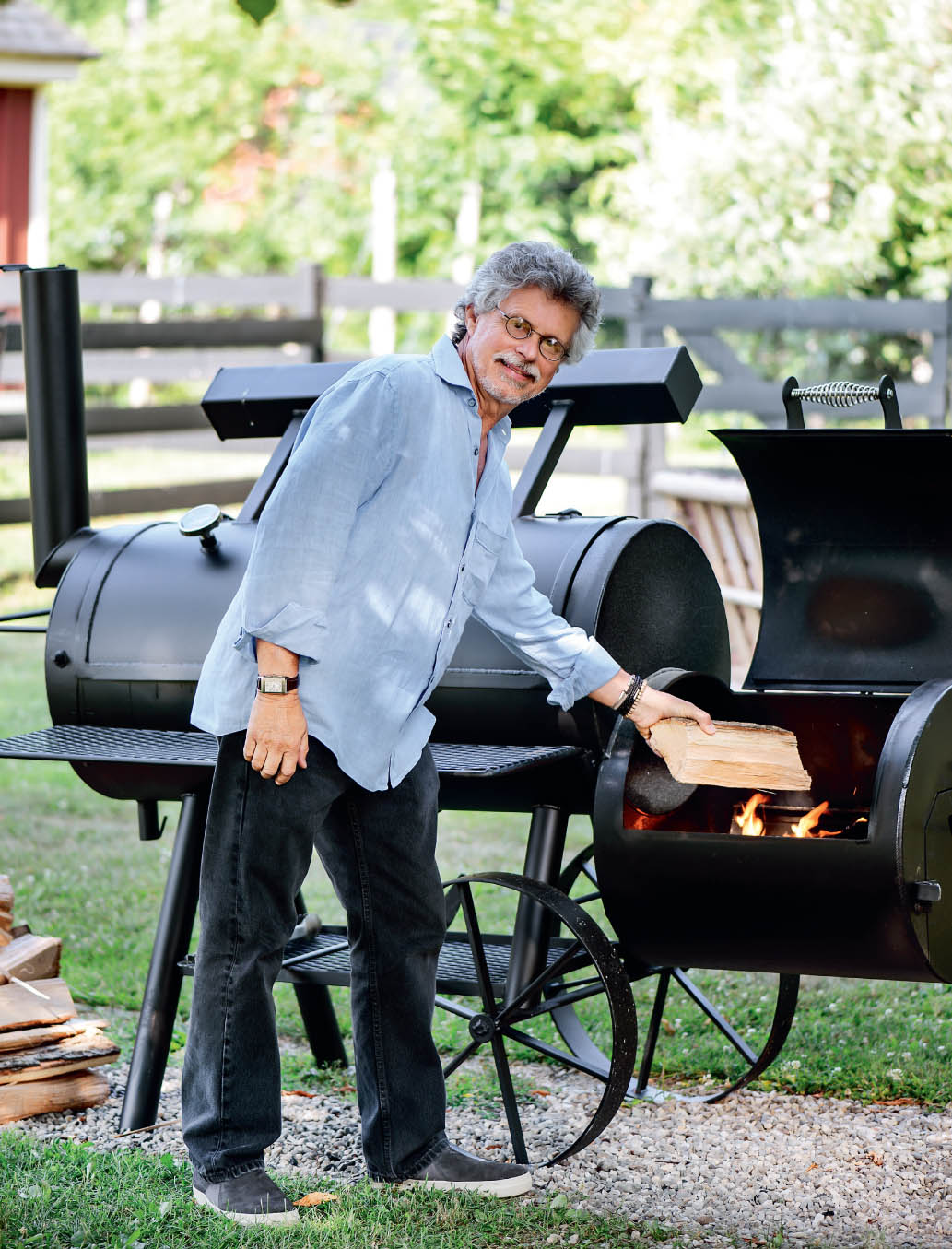

Chapter 9
Tradition calls for certain sacrosanct side dishes to accompany brisket. You know the suspects: baked beans, coleslaw, some sort of potato. What you may not realize is how much brisket itself can enhance a conventional side dish. Baked beans? Obvious. Baked beans laced with smoky brisket chunks? Inspired. Ditto baked stuffed potatoes, which you, barbecue fiend, are going to enrich with burnt ends. Other sides are designed to counterpoint brisket’s belt-loosening richness. Like the cool, crisp cucumber salad served with Korean grilled brisket, or the most innovative cucumber salad of all—the buttermilk, cuke, and rye berry salad served with the New School pastrami sandwich at Harry & Ida’s Meat & Supply Co. in New York. The dishes in this chapter may be served on the side, but when it comes to big flavors, they definitely take center stage.
BRISKET-STUFFED BAKERS
(BAKED POTATOES)
YIELD: Makes 8 halves, enough to serve 8 (or 4 really hungry people as a main course)
METHOD: Indirect grilling
PREP TIME: 15 minutes
COOKING TIME: 1½ hours
HEAT SOURCE: Grill
YOU’LL ALSO NEED: 2 hardwood chunks or 1½ cups chips (if using the latter, soak in water to cover for 30 minutes, then drain); a vegetable brush; a bamboo or metal skewer (for testing doneness)
WHAT ELSE: Don’t have a grill or it’s too cold and snowy to fire it up? You can certainly bake these in the oven. You just won’t get a smoke flavor. I call for Gruyère cheese here (ideally, cave-aged), but white cheddar makes awesome stuffers, too. Ditto for smoked cheese—especially when you’re cooking the potatoes indoors. Note: Sometimes I sauté thinly sliced shallots or onions in place of the scallions.
Bacon and baked potatoes are longstanding bedfellows. But spuds stuffed with smoked brisket? Well, it was only a matter of time before someone brought them together. Brisket makes these larger-than-life bakers beefy and smoky, with scallions and Gruyère cheese rising to a flavor crescendo. They may just be the most outrageous stuffed baked potatoes on Planet Barbecue.
INGREDIENTS
For the potatoes
Vegetable oil, for oiling the grill grate
4 jumbo baking potatoes (14 to 16 ounces each)
2 tablespoons Brisket Butter, melted butter, or extra virgin olive oil, for brushing the skins
Coarse sea salt and freshly ground black pepper
For the stuffing
2 tablespoons butter, Brisket Butter, or extra virgin olive oil, plus 2 tablespoons butter, thinly sliced, for topping
1 bunch of scallions, trimmed and thinly sliced crosswise (set aside 3 tablespoons of the green parts for garnish)
1 cup shredded or chopped barbecued brisket (see here)
3 cups (12 ounces) coarsely grated cave-aged Gruyère or white cheddar
¾ cup sour cream
Sea salt and freshly ground black pepper
Pimentón (Spanish smoked paprika), for sprinkling
1. Set up your grill for indirect grilling see here) and heat to medium-high. Brush or scrape the grill grate clean and oil it well.
2. Scrub the potatoes thoroughly with a vegetable brush. Rinse well and blot dry with paper towels. Prick the skin of each potato all over 4 to 6 times with a fork. (This vents the potatoes and prevents them from exploding from steam buildup.) Brush the potatoes on all sides with the Brisket Butter and season very generously with salt and pepper.
3. Place the potatoes on the grill over the drip pan away from the heat. Toss the wood chips on the coals or, if using a gas grill, place in the smoker box. Cover the grill. Smoke-roast the potatoes until tender, about 1 hour. To test for doneness, pierce a potato through the top with a skewer. It should pierce easily. Transfer the potatoes to a cutting board and let cool slightly (cool enough to handle but still hot).
4. Meanwhile, make the stuffing: Melt 2 tablespoons of butter or heat 2 tablespoons of olive oil in a large saucepan over medium-high heat. Add the sliced scallions and cook, stirring occasionally, until lightly browned, 4 minutes. Remove the pan from the heat and let it cool to room temperature.
5. Cut each cooked potato in half lengthwise. Using a spoon, scrape out most of the potato flesh, leaving a ¼-inch-thick wall next to the skin. Very roughly chop the scooped potato flesh and place it in the saucepan with the scallions. Gently stir in the brisket, 2 cups of the grated cheese, the sour cream, and salt and pepper to taste. The mixture should be highly seasoned. Stir as little as possible to leave some texture to the potatoes.
6. Scoop the potato mixture back into the potato skins, mounding it in the center of each. Sprinkle the remaining cheese over the potatoes and top with the 2 tablespoons thinly sliced butter. Sprinkle each stuffed potato with pimentón. The potatoes can be prepared up to 24 hours ahead to this stage, covered with plastic wrap, and refrigerated.
7. Just before serving, reheat the potatoes on your grill (still set up for indirect grilling) until the stuffing is browned and bubbling, 20 to 30 minutes, or as needed. Sprinkle with the reserved scallion greens and dig in!
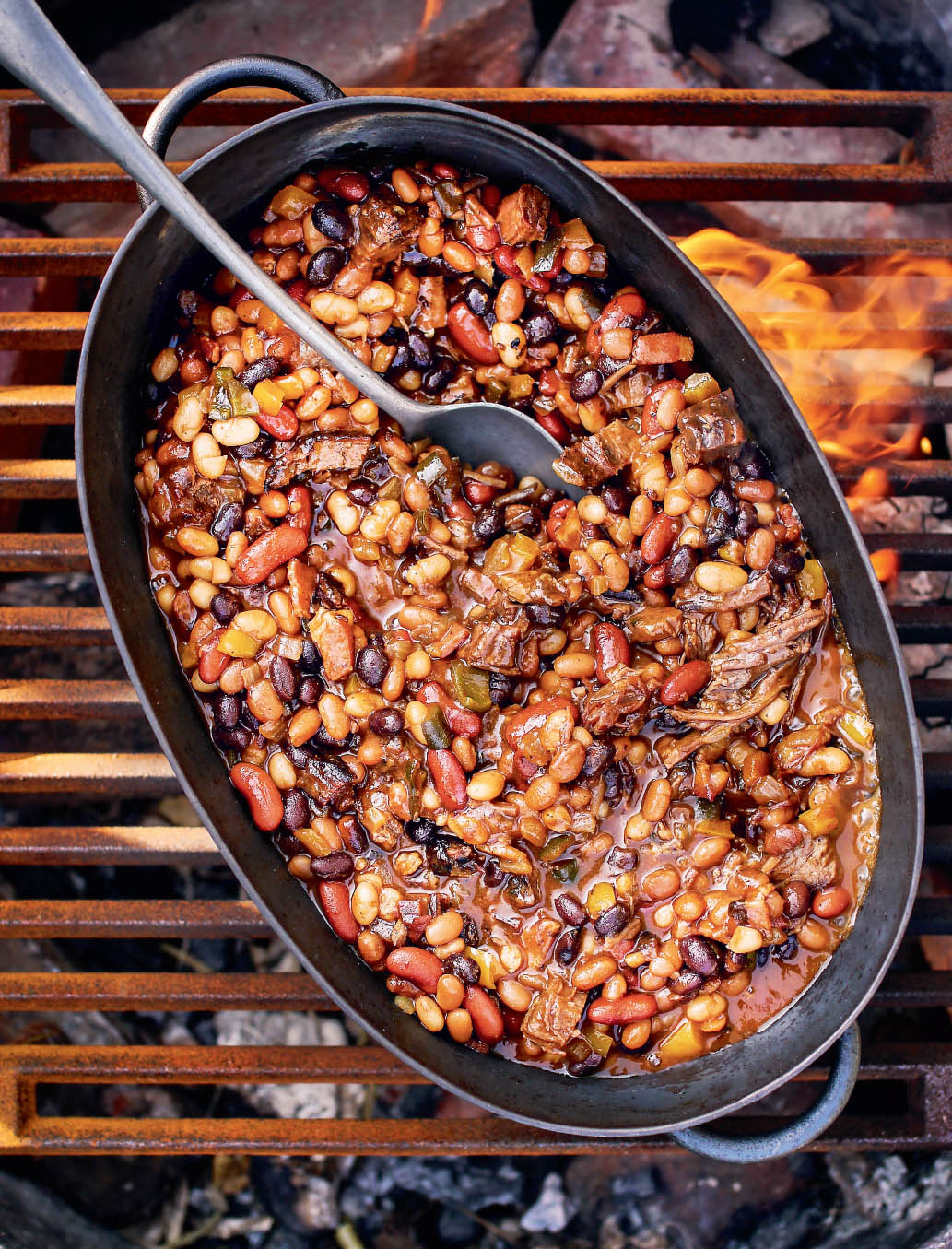
BRISKET BAKED BEANS
(FOUR BEANS, MUCHO BRISKET)
YIELD: Makes 12 cups; serves 10 to 12
METHOD: Smoking (though you can also indirect grill or bake the beans)
PREP TIME: 20 minutes
COOKING TIME: 1½ to 2 hours
HEAT SOURCE: Smoker (or grill or oven)
YOU’LL ALSO NEED: A Dutch oven or heavy-bottomed pot with a tight-fitting lid or a large heavy-duty aluminum foil roasting pan
WHAT ELSE: Sure, you can simmer or bake the beans in a large pot (see Variations), and you’ll get good smoke flavor from the brisket. But for even more smoke flavor, barbecue them in an open Dutch oven (or a large, heavy-duty aluminum foil pan) in your smoker. As you cook your way through the recipes in this book, you’ll make a lot of brisket. I hope you’ll accumulate the trimmings and odd pieces in the freezer, so you always have brisket on hand for this and the other recipes in this chapter. Note: You drain the canned beans, but not the canned baked beans.
Like barbecued brisket, baked beans have deep roots in American food culture. Native Americans cooked them with maple sap and bear fat, using fire-scorched stones for heat. European colonists adopted the dish, adding salt pork for fat and molasses as a sweetener. Today, baked beans are inextricably woven into the fabric of American barbecue and they’re about to get a lot better. With brisket. Lots of brisket. This is a great place to use up all those burnt ends and brisket trimmings. Sweet, salty, smoky, and, above all, meaty, these are everything you hunger for in baked beans—and more.
INGREDIENTS
4 strips thick-sliced artisanal bacon, such as Nueske’s, cut crosswise into ¼-inch slivers
1 large onion, peeled and cut into ¼-inch dice
1 poblano chile, stemmed, seeded, and cut into ¼-inch dice
1 red or yellow bell pepper, stemmed, seeded, and cut into ¼-inch dice
3 jalapeños, stemmed, seeded, and diced
2 cloves garlic, peeled and minced
½ cup chopped fresh cilantro
1 can (15 ounces) baked beans (preferably organic) with can juices
1 can (15 ounces) black beans (preferably organic), drained
1 can (15 ounces) red kidney beans (preferably organic), drained
1 can (15 ounces) navy beans (preferably organic), drained
1½ cups your favorite sweet red barbecue sauce
⅔ cup packed brown sugar, plus extra as needed
½ cup dark beer, plus extra as needed
⅓ cup Dijon mustard
2 cups chopped barbecued brisket (see here)
Coarse salt (sea or kosher) and freshly ground black pepper
1. Place the bacon in a large Dutch oven or heavy-bottomed pot. Place over medium-high heat and cook, stirring occasionally, until sizzling and golden, 3 minutes.
2. Add the onion, poblano, bell pepper, jalapeños, garlic, and ¼ cup of the chopped cilantro and cook, stirring occasionally, until lightly browned 3 to 4 minutes more.
3. Stir the beans into the bacon mixture. Stir in the barbecue sauce, sugar, beer, mustard, and brisket. You can cook the beans in the Dutch oven, or transfer them to a large heavy-duty aluminum foil roasting pan.
4. Set up your smoker following the manufacturer’s instructions and heat to 275°F. Smoke the beans, uncovered, until thick, concentrated, and richly flavored, 1½ to 2 hours. If they start to dry out, stir in a little water or more dark beer and put the lid on the Dutch oven or cover the pan tightly with aluminum foil.
5. Correct the seasoning, adding salt, pepper, or sugar to taste. The beans should be very flavorful. Sprinkle the remaining ¼ cup chopped cilantro on top. Dig in!
Brisket Baked Beans will keep, in a sealed container in the refrigerator, for at least 3 days.
Variations
Grill method: Set up your grill for indirect grilling (see here) and heat to medium. If using a charcoal grill, toss 1½ cups wood chips (soaked in water to cover for 30 minutes, then drained) or 2 hardwood chunks on the coals. If using a gas grill, place wood chunks under the grate over the heat diffusers. In step 4, smoke-roast the beans, uncovered, until they are thick, concentrated, and richly flavored, 40 to 60 minutes.
Oven method: Preheat the oven to 275°F. In step 4, bake the beans, uncovered, until thick, concentrated, and richly flavored, 1½ to 2 hours.
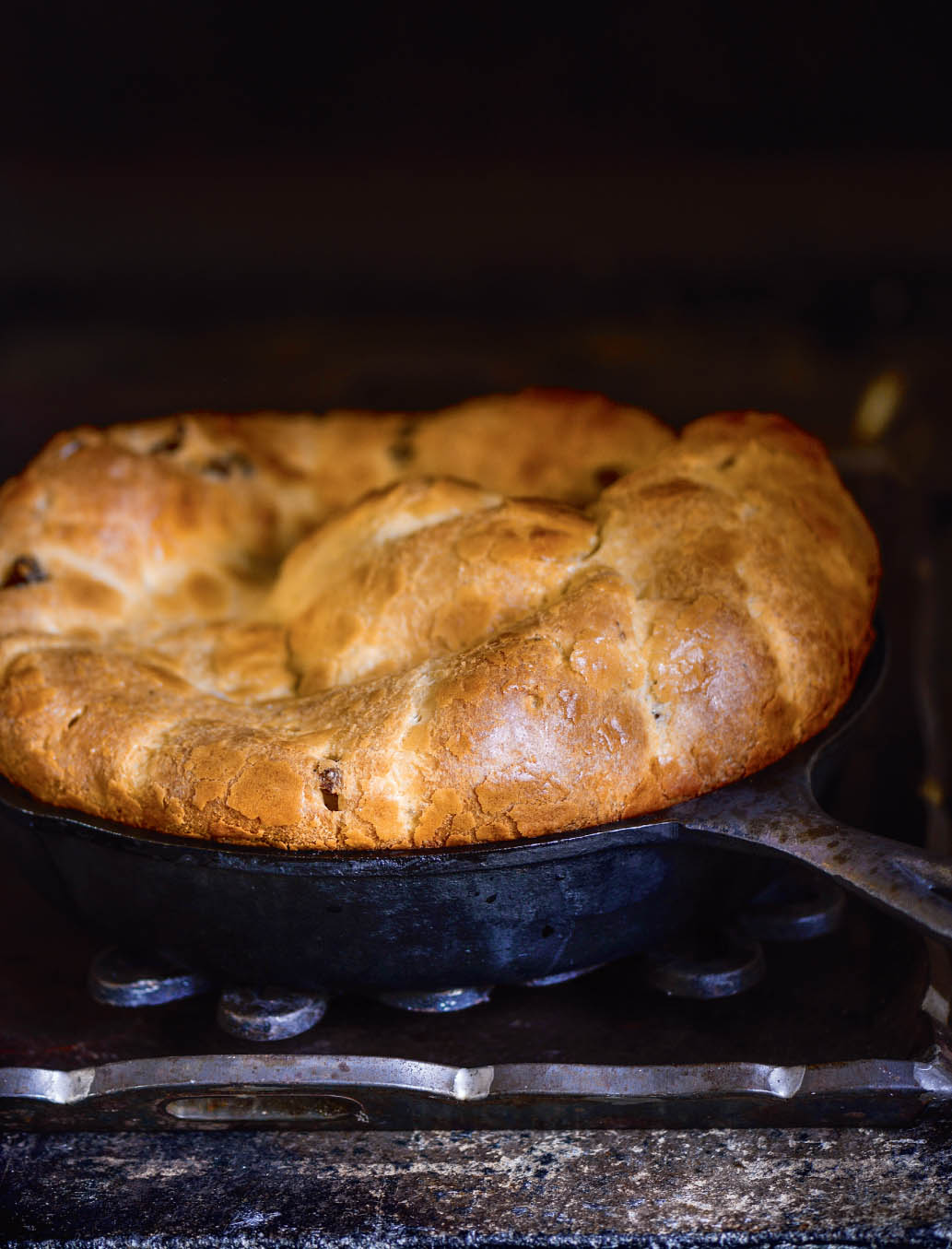
BRISKET YORKSHIRE PUDDING
YIELD: Makes 1 Yorkshire pudding (serves 4 to 6)
METHOD: Baking
PREP TIME: 10 minutes
COOKING TIME: 30 to 40 minutes
HEAT SOURCE: Oven
YOU’LL ALSO NEED: A 10-inch cast-iron skillet
WHAT ELSE: This recipe produces a single magisterial Yorkshire pudding, but you can also bake the batter in popover molds to make 6 individual popovers; see the Variation.
Yorkshire pudding. Dutch babies. Popovers. Three names for one simple eye-popping pastry—a flour, milk, and egg batter traditionally enriched with roast beef drippings and baked to a towering puff. Did someone say drippings? As good as roast beef drippings are, nothing rivals brisket drippings. Same luscious beefy flavor, but aromatized with wood smoke.
INGREDIENTS
6 large eggs (preferably farm-fresh and organic)
2¼ cups cold milk (preferably whole milk)
1 teaspoon sea salt or kosher salt
½ teaspoon freshly ground black pepper
2 cups unbleached all-purpose flour
¼ cup brisket drippings, Brisket Butter, or melted butter
½ cup finely chopped barbecued brisket (see here)
1. Combine the eggs, milk, salt, and pepper in a large mixing bowl and whisk or blend to mix. Whisk in the flour and 3 tablespoons of the brisket drippings. Stir in the chopped brisket. Chill the mixture, covered, in the refrigerator for at least 2 hours, or overnight. (For a crispier crust and less dense pudding, allow the batter to sit at room temperature for an hour after chilling and before baking.)
2. Preheat the oven to 450°F.
3. Use the remaining tablespoon of brisket drippings to grease the bottom and side of a 10-inch cast-iron skillet. (Tilt the pan to coat it.) Place the skillet in the oven and heat for 5 minutes.
4. Remove the hot pan and carefully pour the batter into it. Return the pan to the oven and bake for 10 minutes, then lower the heat to 400°F. Continue baking until the pudding is dramatically puffed and handsomely browned on top, about 20 minutes more. Don’t open the oven door to peek—at least not for the first 20 minutes, or the cool air will deflate the pudding.
5. Cut the pudding into wedges and serve immediately.
Variation
Brisket Popovers: Prepare the pudding batter as directed. In step 3, use the remaining tablespoon of brisket drippings to grease the bottom and sides of a 6-cup popover pan. Place the pan in the oven and heat for 5 minutes. Bake as directed in step 4. Remove the popovers from the pan and serve immediately.
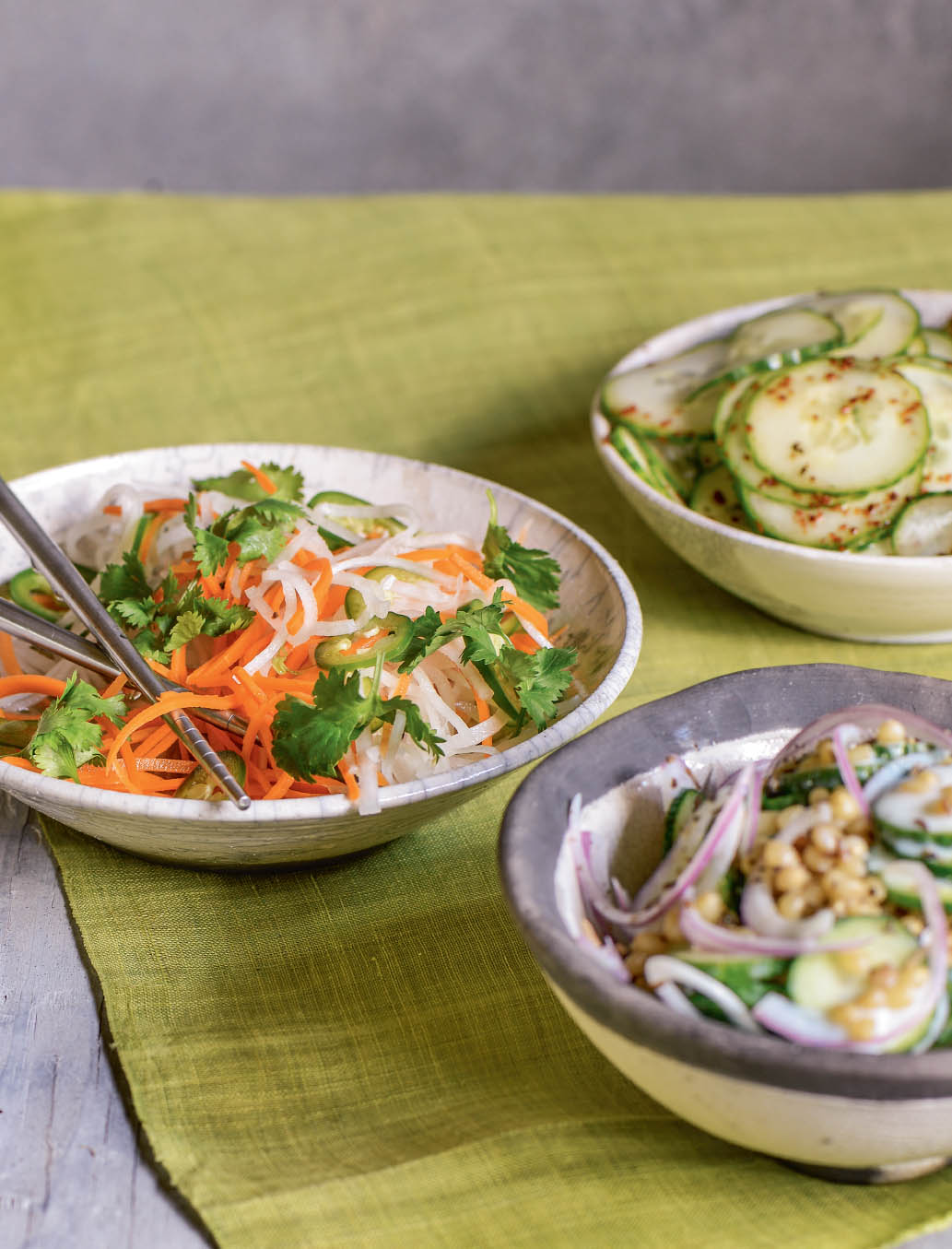
A trio of crunchy-crisp salads (clockwise from left): Vietnamese Slaw, Korean Cucumber Salad, and Cucumber, Buttermilk, and Rye Berry Salad
KOREAN CUCUMBER SALAD
YIELD: Serves 4
PREP TIME: 10 minutes
WHAT ELSE: You want a cucumber with a high flesh-to-seed ratio, like a Kirby, Persian, or European cucumber. Barring that, use conventional cucumbers: Cut them in half lengthwise, scoop out the seeds with a spoon, and thinly slice crosswise. Gochugaru is a Korean hot pepper powder. (It’s hot, but not brutally so.) Look for it at an Asian market or substitute hot paprika.
This spicy cucumber salad is part of the banchan—a table-burying condiment and salad selection—that invariably accompanies Korean barbecue. Like the kosher dills traditionally served with pastrami and the sauerkraut piled on corned beef, these crisp sweet-sour cucumber slices bring contrapuntal fire and crunch to the meaty chew of the brisket.
INGREDIENTS
2 to 3 Kirby or Persian cucumbers or 1 European cucumber, trimmed and thinly sliced crosswise (2 cups)
2 tablespoons sugar, or as needed
1 tablespoon Korean hot pepper powder (gochugaru) or hot paprika
2 tablespoons rice vinegar, or as needed
Sea salt or kosher salt
Place the cucumbers, sugar, and hot pepper powder in a mixing bowl and toss to coat. Let stand for 5 minutes. Stir in the vinegar and add salt to taste. The cucumbers should be a little sweet, a little sour, and pugnacious without quite being incendiary.
Store Korean Cucumber Salad in a sealed container in the refrigerator for 2 days. It tastes best served the day it’s made.
CUCUMBER, BUTTERMILK, AND RYE BERRY SALAD
YIELD: Serves 4 to 6
PREP TIME: 15 minutes, plus 1 day for soaking the rye berries
COOKING TIME: 1 to 1½ hours for cooking the rye berries
HEAT SOURCE: Stove
WHAT ELSE: You can buy rye berries (unground rye grain) in bulk at Whole Foods and other natural foods markets. Note: You’ll need to soak the rye berries for a day, so plan accordingly.
As in the previous recipe, you want a cucumber with a high ratio of flesh to seeds. European cucumbers (aka hothouse cucumbers)—the sort sold individually shrink-wrapped in plastic—come to mind. So do Persian cukes and small Kirbys. If using conventional cucumbers, peel and seed them as described here.
Pastrami and other brisket dishes have a natural affinity for cucumbers and rye. How else do you explain our collective fondness for pickles with pastrami and corned beef, and rye as their preferred sandwich bread? Cukes and rye come together in this cool, crisp, piquant salad, which is served with the extraordinary pastrami sandwiches at Harry & Ida’s Meat & Supply Co. in New York—the perfect foil for the fatty richness of the meat.
INGREDIENTS
1 cup rye berries (see What Else)
2 European cucumbers or 4 to 6 Persian cucumbers, trimmed and thinly sliced crosswise (3 to 4 cups)
1 small red onion, peeled, halved, and sliced crosswise paper-thin
½ cup buttermilk
½ teaspoon finely grated lemon zest
2 tablespoons freshly squeezed lemon juice, or to taste
½ teaspoon caraway seeds
Sea salt and freshly ground black pepper
1. Place the rye berries in a large bowl with cold water to cover by 4 inches. Let soak in the refrigerator for 24 hours.
2. Drain the rye berries. Place in a large pot with water to cover by 3 inches. Boil until just tender, 1 to 1½ hours. Drain the rye berries in a colander and rinse with cold water until cool. Drain again and transfer to a mixing bowl. (The berries can be cooked up to 2 days ahead, then covered and refrigerated.)
3. Stir in the cucumbers, onion, buttermilk, lemon zest, lemon juice, and caraway seeds. Add salt and pepper to taste—the salad should be highly seasoned.
Store Cucumber, Buttermilk, and Rye Berry Salad in a sealed container in the refrigerator. It tastes best served the day it’s made.
MADE-FROM-SCRATCH SAUERKRAUT
YIELD: Makes 4 to 6 cups
PREP TIME: 15 minutes
COOKING TIME: 4 hours for salting the cabbage, plus 2 to 4 weeks for curing the sauerkraut
YOU’LL ALSO NEED: A cabbage shredder, mandoline, or food processor with a slicing disk; a large ceramic crock (about 1 gallon); a clean cotton cloth
WHAT ELSE: I prefer sauerkraut with a kick, so I like to add jalapeños and black peppercorns. The purist can certainly omit them. For a more delicate kraut, use savoy cabbage in place of the green cabbage.
Sauerkraut traditionally accompanies two of the world’s greatest incarnations of brisket—corned beef and pastrami. Sure, you can buy commercial kraut, but it’s easy and immensely satisfying to make your own.
INGREDIENTS
3 pounds (1 to 2 heads) green cabbage
1 to 2 jalapeños, stemmed and thinly sliced (optional)
3 tablespoons coarse sea salt
2 teaspoons caraway seeds
2 teaspoons juniper berries, lightly crushed with the side of a knife
2 teaspoons whole black peppercorns
Spring water
1. Cut each cabbage in quarters from top to bottom using a large chef’s knife. Cut out and discard the core. Remove any wilted or blemished leaves. Slice the cabbage crosswise into very thin ribbons by hand, on a cabbage shredder or a mandoline, or in a food processor fitted with a slicing disk.
2. Place the sliced cabbage in a large mixing bowl and sprinkle with the jalapeños (if using), salt, caraway seeds, juniper berries, and peppercorns. Mix well, kneading with your hands. The idea is to bruise the cabbage so it releases its liquid more readily. Lay plastic wrap directly on top of the cabbage, then place a heavy dinner plate or a saucepan filled with canned goods on top of it to act as a weight. Let the pressed mixture macerate at room temperature for 4 hours. The cabbage should feel moist and spongy.
3. Transfer the cabbage mixture to a clean crock and pack it as tightly as possible. Place a clean weight, like a heavy dinner plate, on top. This weight helps force the water out of the cabbage and keep it submerged in the brine. Cover the crock with a clean cotton cloth to keep out airborne debris.
4. Allow the cabbage to ferment in a cool, dark cabinet or basement (60° to 70°F is ideal) overnight, then check it: If the cabbage is not completely submerged in brine, add enough spring water to cover. Replace the weight, cover the crock again, and return it to a cool, dark place to continue fermenting. Check the kraut daily. Sometimes mold appears on the surface of the brine. Skim as much as you can off the surface—it may break up and you might not be able to remove all of it. Don’t worry about it—it’s just a surface phenomenon. The sauerkraut itself is under the anaerobic protection of the brine.
5. Taste the cabbage every 4 to 5 days. It will start to taste like sauerkraut after about a week. The flavor will continue to deepen over time. The fermentation process typically takes 2 to 4 weeks, though the exact duration will depend on the time of year and precise storage conditions. Once you get the amount of “funk” you like, remove the weight. Your sauerkraut is ready to serve.
Made-From-Scratch Sauerkraut will keep, with its juices, in sealed jars in the refrigerator, for several months.
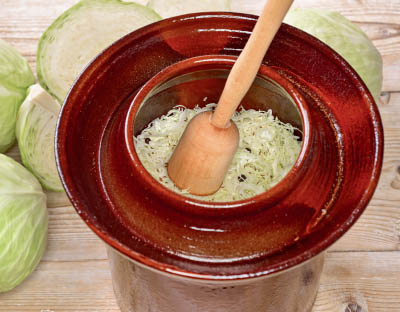
Pack the shredded cabbage as tightly as possible in an earthenware crock.
LONE STAR TOAST
(GRILLED GARLIC BREAD)
YIELD: Makes 12 slices, enough to serve 6 to 12
METHOD: Direct grilling
PREP TIME: 10 minutes
COOKING TIME: Quick—2 minutes per side
HEAT SOURCE: Charcoal, gas, or wood-burning grill
Lone Star toast is Texan for grilled garlic bread. You’ll want a Pullman or country-style loaf—white bread with a denser crumb than the factory white bread that usually accompanies Texas brisket. Buy it at a local bakery. In a pinch, you could use Pepperidge Farm.
INGREDIENTS
For the garlic butter
3 cloves garlic, peeled and minced
½ teaspoon sea salt
½ teaspoon freshly ground black pepper
12 tablespoons (1½ sticks) unsalted butter, at room temperature
3 tablespoons minced fresh flat-leaf (Italian) parsley or chives
For the grilled Bread
1 country-style loaf or Pullman white bread, cut crosswise into ¾-inch-thick slices
Vegetable oil, for oiling the grill
1. Place the garlic, salt, and pepper in the bottom of a mixing bowl and mash to a paste with the back of a spoon. Add the butter and parsley or chives and whisk until smooth. Note: Do not use a food processor, or you’ll turn the butter green.
2. Using a palette knife or butter knife, spread the bread slices on both sides with a thin, even layer of garlic butter.
3. Set up your grill for direct grilling (see here) and heat to medium-high. Brush or scrape the grill grate clean and oil it well. Be sure to leave a fire-free safety zone—a section of the grill that is not lit or burning—in case a flare-up occurs or the bread starts to burn.
4. Arrange the bread slices on the grill. Grill until sizzling and golden brown on both sides, 1 to 2 minutes per side, turning with tongs. Serve immediately, hot off the grill.
